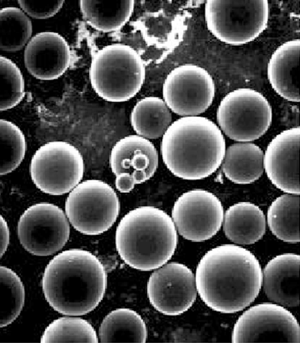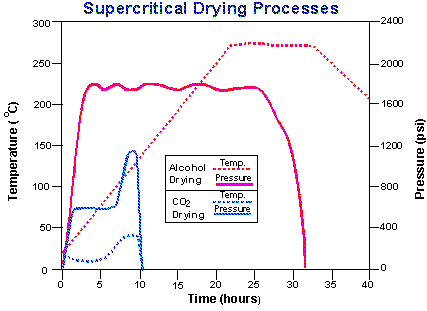
Synthesizing Aerogels
Kistler's Method
Samuel S. Kistler's initial method was not ever recorded precisely but the process he provided to Monsanto Chemical
Company were very elaborate and precise. It is obvious that he had carefully refined his original method for efficient mass
production in a factory setting. The following is an description of the process of creating aerogels at Monsanto Chemical Co. from
Chemical and Metallurgical Engineering (February 1943 pg.144).
Production of Silica Aerogel
The first large scale production unit for silica aerogel has recently commenced operations at the plant of Monsanto Chemical Co. at Boston, Mass. The product is a light, friable, slightly opalescent solid containing as much as 95 percent air volume. It is a very effective heat insulating material. Silica aerogels having densities as low as 1.8 lb. per cu.ft. have been produced.
The process consists of adding a solution of sodium silicate to sulphuric acid. Concentrations are controlled to yield a gel having 8 percent silica. After aging several hours to allow the gel to strengthen, due to syneresis phenomena, it is removed from the tank and passed through the roll crusher into one of four wash tanks. Water is passed up through this tank over the gel to remove the sodium sulphate formed in the gel preparation reaction. When the gel has been sufficiently washed, all excess water is removed by draining and the gel is then covered with alcohol. After a suitable soaking time the alcohol is drained off and replaced with a fresh portion. The alcohol washing procedure is done by the use of a conventional 4-stage counter-current system. Greater economy of alcohol is realized by using the cover, soak and drain method of washing in place of continuous how through the tanks. The counter-current cycle is facilitated by use of the wash receivers and the transfer pump. Weak alcohol taken from the system is recovered as strong alcohol by fractionation in a recovery column.
When the water in the gel has been substantially replaced with alcohol, the excess alcohol is drained off and the gel charged to the autoclave. Here it is heated to 550 deg. F., the pressure being held to 1150 lb. gage by bleeding of alcohol vapor through the condenser. When 550 deg. F. is reached the pressure is reduced to atmospheric and the autoclave is finally evacuated to 20 in. mercury for 10 min. The resultant aerogel is then removed by a conveyor system. The autoclave is heated by a jacket containing diphenyl vapor at 80 lb. gage pressure, this vapor being supplied by the oil fired diphenyl boiler.
The process is built around one essential unit operation involving a unique step, i.e., the heating of a gel system to temperatures and pressures above the critical for the liquid phase present in the gel.
Sol-Gel Chemistry
To understand Sol-Gel Chemistry, we must first know the meaning Sol and the Gel Point. Sol is defined as "A solution of
various reactants that are undergoing hydrolysis and condensation reactions." The molecular weight of the oxide species produced
in the Sol continuously increases; ergo the oxide multiplies and becomes larger. As the species grow, they may begin to link
together to form a three-dimensional substrate. The Gel Point is defined as being "The point in time at which the network of linked
oxide particles spans the container holding the Sol." At the gel point, the Sol becomes an 'alcogel'. In Sol-Gel method, you
normally take either TMOS or TEOS and place it in a container with water in a 1:2 molecular ratio. That is your Sol and you use it
to form a silicon alkoxide "wet gel." This method eliminates the long process of making a wet gel by aqueous condensation of
sodium silicate and then having to repetitively "wash" it of the salts thatform within a sodium silicate gel. The washing process was
usually a very time and energy consuming procedure. The Sol-Gel method also allows you a much greater degree of control over
the final product than Kistler's method.
Catalysts
The formation of the alcogel from the Sol is actually a very slow process when a catalyst is not present. The formation
could take days without an acid or base catalyst being added to the Sol. The catalyst can be any protic acid, such as HBr, or a in
the case of a basic catalyst you usually use ammonia and ammonium fluoride. A basic catalyst may be more preferable because
generally aerogels formed with acid catalysts are more likely to shrink during the supercritical drying and they also are less
transparent than those formed with basic catalysts. The actual structural differences between aerogels formed with different
catalysts are harder to see due to the particles being so small (2-5 nm in diameter) that you need an electron microscope to see
them. Using a basic catalyst, the particles are spherical or egg-shaped and smooth. With an acidic catalyst, the particles more
closely resemble "balls of string."

Picture of Aerogel Microspheres
(Taken with electron microscope)
Patience is a virtue
One of the biggest mistakes you can make while synthesizing an aerogel is rushing the process. Creating aerogel requires
you to have patience and allow processes to complete themselves before moving on to the next step. One critical point where the
common mistake of being impatient takes place is when the gel point is reached. Some people assume that when the gel point is
reached, you are ready to continue on in the procedure. However, this is simply beacuse they do not fully understand the meaning
of the gel point. The gel point is simply the point when the silica species undergoing polymerization spans the container containing
the sol. However, this does not mean that the gel has fully formed. There are commonly many sites within structure of unreacted
alkoxides. It may take several times over the time needed for gelation to complete the reaction. The gel normally must be "aged."
Aging involves controlling the amount of water in the solution and the pH of the solution. You want to keep the solution at a pH
close to that of the catalyst. The gels turn out best when left in this solution for up to 48 hours. Once the gel has been aged, all the
water still contained within the gel's pores must be removed prior to drying. This is accomplished by soaking the gel in pure
alcohol multiple times until the water is completely removed. If any water is left in the gel, it will not be removed by supercritical
drying and this will lead to an opaque, white, and very dense aerogel product which is obviously far from desirable.
The processes of aging and soaking however are both dependent on one thing. The thickness of the aerogel is very
important because these steps are both diffusion-controlled. Diffusion controlled means that transport of material into, and out of,
the gel is unaffected by convection or mixing (due to the solid silica structure). Diffusion, however, is affected by the thickness of
the gel. Therefore, the time required for each step increases as the thickness of the gel increases.
The All Important Final Step
Supercritical drying is the most crucial part in the synthesis of aerogels. In this terminal step, the liquid within the gel
(whatever it may be) is removed, leaving only the solid structure. The process can be performed by venting the ethanol above its
critical point (high temperature needed and very dangerous) or by prior solvent exchange with CO2 followed by supercritical
venting (lower temperature needed and less dangerous). This process should only be performed in an autoclave specially designed
for this explicit purpose.
The alcogels are placed in an autoclave which normally has been filled with ethanol. The system is pressurized to at
least 750-850 psi with CO2 and cooled to 5-10 °C. Liquid CO2 is then flushed through the autoclave until the ethanol has been
completely removed from the container and from within the gels. When the gels are ethanol-free, the autoclave is heated to a
temperature above the critical temperature of CO2 (31 °C). As the autoclave is heated the pressure of the system rises as would be
expected when volume is maintained. CO2 is carefully released to maintain a pressure slightly above the critical pressure of CO2
(1050 psi). The system is held above these critical points for a short time. There is then a slow, controlled release of CO2
to normalize the pressure. As said previously, the length of time required for this process is dependent on the thickness of the gels.
The process could last anywhere from 12 hours to 6
days.

Comparison of required pressures and
temperatures for supercritical drying
(CO2 vs Alcohol)
Discovery and History // Synthesizing Aerogels // Uses: Current and Future // Research and What Lies Ahead